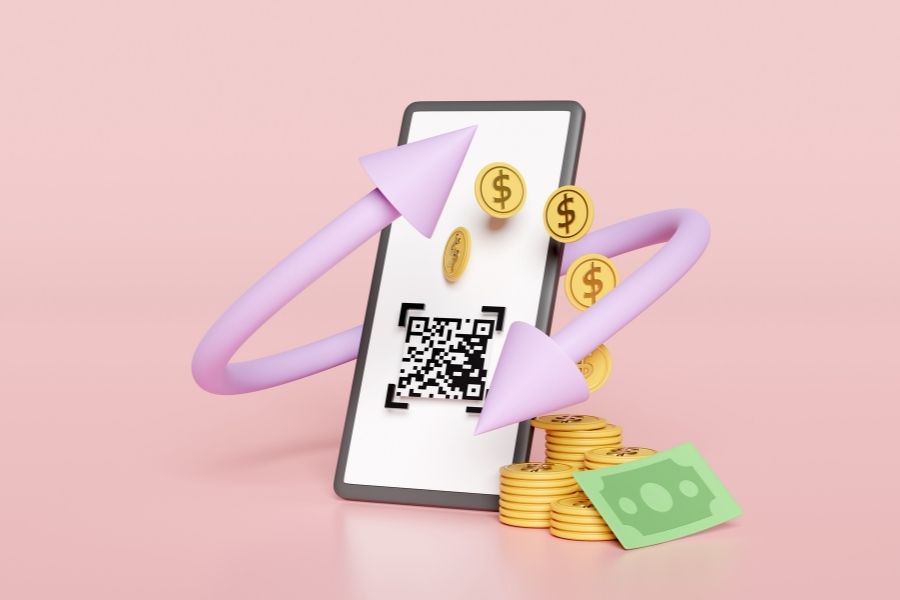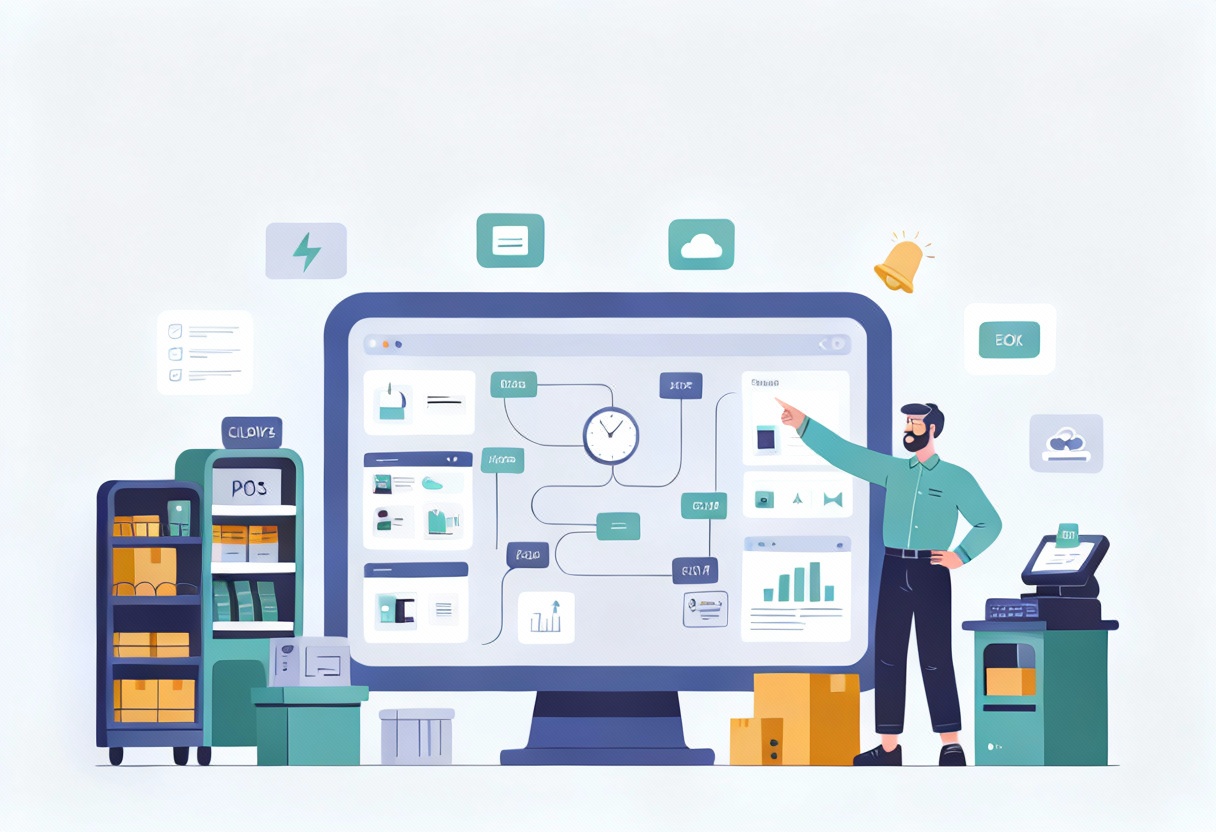Manual marketing gets messy fast, especially when your store juggles dozens of products and platforms. Ecommerce marketing automation software keeps the chaos in check. It runs the campaigns you don’t have time for, connects data you forgot existed, and helps you stay one step ahead of every cart left behind. This ConnectPOS’s guide walks you through what these tools really do, how to choose the right one, and which platforms actually work in retail stores like yours.
Highlights:
- The right ecommerce marketing automation tool should be easy to use, connect with your channels, support multi-touch campaigns, and scale with transparent pricing and smart reporting.
- From ConnectPOS to Klaviyo, these 8 platforms bring different strengths, from personalization to omnichannel support, so your pick should match how you sell and grow.
What Is The Role of e-commerce marketing Automation Software?
E-commerce marketing automation software streamlines and personalizes marketing efforts for online businesses, allowing for the automation of repetitive tasks like email campaigns, customer segmentation, and personalized product recommendations. This automation not only saves time and resources but also enhances the customer experience by delivering targeted and timely communications, ultimately driving sales and fostering stronger customer relationships.
Automation doesn’t replace marketing. It runs the parts most people don’t enjoy, like tagging cold leads, sending reminders, or pulling reports after midnight. It’s the quiet engine behind every welcome email, back-in-stock alert, or perfectly-timed birthday offer.
These tools make sure no customer falls through the cracks. Whether it’s nudging someone who left their cart or syncing loyalty points right after checkout, everything happens like clockwork. Good automation fills the gaps that manual effort can’t keep up with.
The real magic? These systems run 24/7. Even while your team sleeps, the software keeps tracking, segmenting, and reaching customers at just the right time. It doesn’t just save effort, it creates consistency.
Need to push a flash sale or restock alert? One setup handles it all across email, SMS, and your POS. That’s why more retailers are turning to automation not as a bonus, but as a must-have.
How Does Ecommerce Marketing Automation Software Drive Business Results?
Retail moves fast. Marketing automation moves faster.
You don’t have to babysit every email or campaign. These systems pull real-time data, apply smart logic, and act instantly, while humans are still drafting a subject line.
That means fewer mistakes. No more missed follow-ups, wrong coupon codes, or sending a welcome email to someone who already bought twice. It also means better timing. McKinsey found that personalized automation can lift sales by up to 15%. And 72% of online buyers expect brands to remember who they are and what they like. Automation makes that possible.
The payoff shows up everywhere:
►►► Optimal solution set for businesses: Multi store POS, Next-gen POS, Inventory Management Software (MSI), Self Service, Automation, Backorders
- Abandoned cart flows bring back shoppers you thought were gone.
- Upsell emails drop right after checkout, when attention is highest.
- Low-stock alerts trigger urgency, while back-in-stock messages recover missed sales.
- Loyalty points sync in real-time across channels.
It’s not just about saving time. It’s about using time better.
And for omnichannel stores, it’s the glue between systems. ConnectPOS, for example, links POS data with Atom8’s automation engine. So when a customer spends big in-store, they get tagged, segmented, and followed up with, automatically.
Retailers who treat automation as a growth tool, not a shortcut, see better retention, more repeat purchases, and sharper ROI. AI‑focused startups raised $19 billion in Q3 2024 alone, 28% of all venture funding, showing investor confidence in this space.
What To Look For in Ecommerce Marketing Automation Software?
The best ecommerce marketing automation software doesn’t just ‘tick boxes’. It fits your team, your tech stack, and your customers. Before you commit, make sure the platform covers these bases.
- Ease of use and onboarding: A clean interface and drag-and-drop builder save time. You shouldn’t need an IT degree to launch a cart recovery flow.
- Integration with your sales channels: Look for tools that sync in real time with Shopify, BigCommerce, Magento, WooCommerce, or your POS system. ConnectPOS, for instance, syncs seamlessly with Atom8 to close the online-offline gap.
- Range of marketing channels supported: Email is the starting line. But SMS, push, WhatsApp, and even in-app notifications matter too. The more flexible, the better.
- Flexibility – rules, segmentation, and custom triggers: Set conditions by order value, product type, or time of day. Auto-tag VIPs, flag dormant buyers, and personalize follow-ups without writing scripts.
- Reporting and analytics capabilities: Don’t just chase open rates. A good platform shows conversion, revenue per campaign, and lifetime value by flow.
- Pricing transparency and scalability: Watch out for steep jumps tied to list size. Flat pricing or tiered plans make growth predictable and budget-friendly.
Finding the right fit comes down to balance: smart tech that works quietly in the background, and enough control to shape it around your goals.
The Top 8 Ecommerce Marketing Automation Software
Some tools focus on emails. Others go deeper, connecting your store data, tracking behavior, and sending the right message at the perfect time. We’ve broken down eight options that help ecommerce stores of all sizes run smarter campaigns and sell more, without stretching your team thin.
ConnectPOS
ConnectPOS combines real-time point of sale with powerful automation. It’s built for retailers who want one platform to manage sales, promotions, and customer engagement across both online and offline channels. Through its deep integration with Atom8, ConnectPOS makes it easier to send the right message at the right time, without bouncing between platforms.
It doesn’t just run transactions. It helps stores sell smarter with built-in triggers, inventory rules, and personalized outreach that runs quietly in the background.
- Real-time sync across online & offline: Keeps product, customer, and order data updated on every channel.
- Omnichannel POS: Works seamlessly for in-store, mobile, and pop-up setups.
- Email/SMS triggers for campaigns: Sends automated messages based on customer activity and store events.
- Flash sales and birthday rewards: Runs limited-time deals or personalized codes with minimal setup.
- Cart recovery & loyalty sync: Reconnects with lost carts and updates points in real time.
- Customer tagging & segmentation: Groups shoppers by behavior, frequency, and order value.
- Inventory-based campaigns: Launch targeted offers when items are overstocked or nearly sold out.
- Offline mode & second screen: Keeps transactions going without internet and enhances checkout visibility.
- Click & collect support: Lets buyers shop online and pick up items on their schedule.
ConnectPOS turns sales activity into marketing triggers, helping retailers lift conversions, run smart promotions, and stay relevant without micromanaging every message.
Omnisend
Omnisend focuses on multichannel communication. It’s built for ecommerce brands that want to manage email, SMS, and push notifications all in one place, without switching tabs or apps.
- Multichannel campaign builder: Combines email, SMS, and push into a single workflow.
- Cart recovery and product recommendations: Nudges shoppers with dynamic content tied to browsing and purchase history.
- Pre-built automation templates: Speeds up setup with ready-to-use flows for welcome, win-back, and post-purchase emails.
- Audience segmentation: Filters customers by behavior, location, or order details.
- Sales tracking and ROI reporting: Connects campaigns to actual revenue, not just clicks.
Klaviyo
Klaviyo is known for deep personalization. It connects tightly with ecommerce platforms and pulls in real-time customer data to shape every email, SMS, and experience.
- Customer profiles and predictive analytics: Tracks behavior and forecasts churn or next purchase.
- Pre-built flows: Includes welcome series, cart recovery, product follow-ups, and more.
- Smart segmentation: Groups users by buying frequency, email engagement, and browsing history.
- Integration with ecommerce and POS: Syncs with Shopify, Magento, and tools like.
- Performance dashboards: Measures results down to revenue per recipient.
ActiveCampaign
ActiveCampaign blends marketing with CRM. It’s designed for stores that want to combine email campaigns with customer pipelines, lead scoring, and behavior tracking.
- Email and SMS marketing automation: Sends targeted messages based on customer actions.
- CRM and lead scoring: Tracks engagement across the buyer journey and ranks contacts.
- Split testing and goal tracking: Optimizes flows and measures progress toward purchases.
- Personalization and conditional content: Customizes each message with product and user data.
- Flexible integrations: Connects with Shopify, WooCommerce, and hundreds of third-party apps.
Brevo (Sendinblue)
Brevo, formerly Sendinblue, offers value-packed tools for small to mid-size brands. It supports basic CRM, transactional emails, and marketing flows under one roof.
- Email, SMS, and WhatsApp support: Covers the most-used channels globally.
- Drag-and-drop automation builder: Launches flows with no coding or training.
- CRM and task manager: Tracks deals and customer touchpoints in one place.
- Transactional messaging: Sends receipts, confirmations, and updates with reliability.
- Affordable pricing tiers: Keeps costs low for smaller lists or newer stores.
HubSpot Marketing Hub
HubSpot is a CRM-first solution with marketing layers built on top. It’s suited for teams that want an all-in-one system to manage leads, campaigns, and analytics.
- Email marketing and landing pages: Combines outreach with data collection tools.
- ABM and lead scoring: Prioritizes accounts and tracks progress in B2B funnels.
- Detailed campaign analytics: Breaks down performance by contact, flow, and asset.
- Workflow automation: Covers everything from emails to internal task creation.
- Strong CRM foundation: Centralizes contacts, deals, and activity in one dashboard.
Bloomreach
Bloomreach is built for large ecommerce operations. It helps teams deliver tailored experiences with AI, product discovery tools, and omnichannel campaigns.
- AI-powered product recommendations: Adjusts suggestions based on browsing and purchase history.
- Email and SMS orchestration: Sends campaigns triggered by real-time behavior.
- Headless CMS: Lets brands personalize content without relying on developers.
- Customer journey mapping: Connects channels to visualize cross-touchpoint paths.
- Enterprise scalability: Handles high volumes of data and traffic without slowdown.
Marketo (Adobe)
Marketo is the enterprise option for brands deep into B2B, ABM, or high-ticket ecommerce. It specializes in lead scoring, long-cycle nurturing, and detailed reporting.
- Advanced lead segmentation: Breaks down users by firmographics, activity, and engagement.
- Campaign performance dashboards: Measures ROI, attribution, and conversion by channel.
- Multi-stage workflows: Builds long-term nurture tracks across email, SMS, and paid ads.
- Sales alignment tools: Connects marketing flows to sales activities and pipelines.
- Deep Adobe ecosystem integration: Works alongside Adobe Analytics, Experience Cloud, and more.
Quick Comparison Table – Top 8 Ecommerce Marketing Automation Software
| Rank | Software | Best For | Key Features | Starting Price |
| 1 | ConnectPOS | Omnichannel retailers needing POS + automation | Real-time sync across online & offlineOmnichannel POS (in-store, mobile, pop-up)Email/SMS triggers for campaignsWelcome emails, flash sales, birthday/inactivity nudgesAbandoned cart remindersAuto customer tagging & segmentationInventory-based campaigns (auto-hide/show, trigger sales)Risk order alerts & automated workflowsLoyalty program supportOffline selling modeSecond screen displayMulti-location inventoryClick & collect options | $49/register/month |
| 2 | Omnisend | Multichannel marketing for ecommerce | Email, SMS, push notifications, cart recovery, product recommendations | Free tier + Paid from $16 |
| 3 | Klaviyo | Ecommerce brands focused on personalization | Segmentation, predictive analytics, pre-built flows, strong Shopify integration | Free tier + Paid from $20 |
| 4 | ActiveCampaign | Businesses needing CRM-driven automation | Email marketing, lead scoring, CRM integration, AI-enhanced automations | Starts at $29/month |
| 5 | Brevo (Sendinblue) | Startups or SMEs needing affordable tools | Email, SMS, WhatsApp, CRM, transactional messages, visual automation builder | Free tier + Paid from $25 |
| 6 | HubSpot | All-in-one CRM + marketing solution | Email, landing pages, ads, ABM, workflows, reporting, strong CRM base | Starts at ~$800/month |
| 7 | Bloomreach | Large ecommerce businesses with complex needs | AI personalization, headless CMS, product discovery, email/SMS campaigns | Custom enterprise pricing |
| 8 | Marketo (Adobe) | Enterprises using ABM and detailed tracking | Advanced lead scoring, campaign management, ABM, segmentation, analytics | Custom enterprise pricing |
How Real Retailers Succeed With Ecommerce Marketing Automation Software
Smart automation shows up in small wins, fewer lost carts, more returning customers, and smoother checkout experiences. It’s not flashy. It just works.
Yeti Cycles, a U.S. retailer using ConnectPOS, turned automation into everyday momentum. By syncing their POS with Atom8, they cut checkout times and avoided stock mismatches. Customers saw real-time inventory, even during peak season, and store staff could follow up automatically with high-spenders. No extra hires. Just smarter workflows.
One fashion brand using Omnisend built a cart recovery flow that didn’t just ‘remind’. It included product ratings, size availability, and a 15% one-time code. Return-to-cart clicks went up. So did conversions.
A mid-sized beauty store tested Klaviyo’s birthday flow. Nothing fancy, just a short SMS and a $10 gift code. Turns out, ‘silent’ shoppers came back, and their average basket value jumped.
None of these results happened overnight. But by setting a few smart triggers, retailers created systems that paid off daily. Less guesswork. More repeat buyers.
How To Choose the Right Ecommerce Marketing Automation Software?
Start simple: what’s your store size, and how does your team work?
If you’re running a multi-location retail business, you’ll want a platform that syncs POS and online activity. Something like ConnectPOS fits this perfectly. If your team is email-focused, lightweight tools with pre-built flows might do the job.
Below is what you should compare when choosing:
- Fit for your store type: A small Shopify shop has different needs than a chain with a POS system. Match tools to your scale and sales model.
- Integration with your ecommerce platform: Make sure it plugs into what you already use, Shopify POS, Magento POS, BigCommerce, WooCommerce POS, etc.
- Templates and flexibility: Check if the software provides ready-to-run flows and lets you tweak rules or build from scratch.
- Analytics depth: Go beyond open rates. Look for insights tied to revenue, LTV, and product behavior.
- Ease of use: Your staff should be able to launch a campaign in minutes, not days.
- Support and onboarding: Responsive help, a real knowledge base, and live chat can save you when something breaks.
- Free trial or demo access: Always test before you pay. Some tools sound great on paper but feel clunky in practice.
Pick the tool that fits how you already work, not the one that promises the most features you’ll never use.
FAQs: Ecommerce Marketing Automation Software
1. What’s the difference between ecommerce automation and regular marketing automation?
Ecommerce automation uses store-specific triggers, like product views, cart events, or order history. Traditional marketing automation leans more on generic CRM data or email clicks.
2. Can automation tools work with my ecommerce platform?
Most tools connect with major platforms like Shopify, Magento, WooCommerce, and BigCommerce. If you’re using a POS like ConnectPOS, look for tools that support real-time sync across channels.
3. Is marketing automation worth the investment for small stores?
Yes, especially if you’re short on time or team size. Even basic flows, like abandoned carts or welcome emails, can win back sales you’d otherwise lose.
4. How hard is it to migrate to new software?
It depends on your setup. Many tools support CSV imports, API connections, or have migration wizards. Testing with a free trial helps uncover issues early.
5. How do these tools handle customer data privacy and compliance?
Top platforms follow GDPR, CAN-SPAM, and other global standards. Most include opt-in tools, data control options, and logs for peace of mind.
Final Thoughts
Smart automation isn’t about sending more emails. It’s about sending the right messages, without wasting time. Whether you’re running flash sales, nudging ‘silent’ shoppers, or syncing loyalty rewards, the right ecommerce marketing automation software helps you sell more with less stress.
Tools like ConnectPOS take it even further. By connecting automation with POS activity, you can turn in-store behavior into online engagement. No extra steps. Just clean data, real-time sync, and campaigns that feel personal. Want to see it in action? Contact us to explore how ConnectPOS fits your retail strategy.
►►► Optimal solution set for businesses: Shopify POS, Magento POS, BigCommerce POS, WooCommerce POS, NetSuite POS, E-Commerce POS



